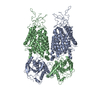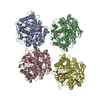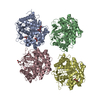+ Open data
Open data
- Basic information
Basic information
| Entry | Database: EMDB / ID: EMD-30543 | |||||||||
|---|---|---|---|---|---|---|---|---|---|---|
| Title | Mouse KCC2 | |||||||||
 Map data Map data | ||||||||||
 Sample Sample |
| |||||||||
 Keywords Keywords | transporter / MEMBRANE PROTEIN | |||||||||
| Function / homology |  Function and homology information Function and homology informationCation-coupled Chloride cotransporters / thermosensory behavior / intracellular pH reduction / hypotonic response / potassium:chloride symporter activity / intracellular chloride ion homeostasis / ammonium channel activity / dendritic spine development / postsynaptic neurotransmitter receptor diffusion trapping / chloride transport ...Cation-coupled Chloride cotransporters / thermosensory behavior / intracellular pH reduction / hypotonic response / potassium:chloride symporter activity / intracellular chloride ion homeostasis / ammonium channel activity / dendritic spine development / postsynaptic neurotransmitter receptor diffusion trapping / chloride transport / postsynaptic specialization membrane / regulation of postsynapse assembly / monoatomic ion transport / potassium ion transmembrane transport / dendrite membrane / dendritic shaft / cell periphery / learning / multicellular organism growth / perikaryon / chemical synaptic transmission / response to xenobiotic stimulus / neuronal cell body / glutamatergic synapse / metal ion binding / membrane / plasma membrane Similarity search - Function | |||||||||
| Biological species |  | |||||||||
| Method | single particle reconstruction / cryo EM / Resolution: 3.8 Å | |||||||||
 Authors Authors | Zhang S / Yang M | |||||||||
 Citation Citation |  Journal: Commun Biol / Year: 2021 Journal: Commun Biol / Year: 2021Title: The structural basis of function and regulation of neuronal cotransporters NKCC1 and KCC2. Authors: Sensen Zhang / Jun Zhou / Yuebin Zhang / Tianya Liu / Perrine Friedel / Wei Zhuo / Suma Somasekharan / Kasturi Roy / Laixing Zhang / Yang Liu / Xianbin Meng / Haiteng Deng / Wenwen Zeng / ...Authors: Sensen Zhang / Jun Zhou / Yuebin Zhang / Tianya Liu / Perrine Friedel / Wei Zhuo / Suma Somasekharan / Kasturi Roy / Laixing Zhang / Yang Liu / Xianbin Meng / Haiteng Deng / Wenwen Zeng / Guohui Li / Biff Forbush / Maojun Yang /   Abstract: NKCC and KCC transporters mediate coupled transport of Na+K+Cl and K+Cl across the plasma membrane, thus regulating cell Cl concentration and cell volume and playing critical roles in transepithelial ...NKCC and KCC transporters mediate coupled transport of Na+K+Cl and K+Cl across the plasma membrane, thus regulating cell Cl concentration and cell volume and playing critical roles in transepithelial salt and water transport and in neuronal excitability. The function of these transporters has been intensively studied, but a mechanistic understanding has awaited structural studies of the transporters. Here, we present the cryo-electron microscopy (cryo-EM) structures of the two neuronal cation-chloride cotransporters human NKCC1 (SLC12A2) and mouse KCC2 (SLC12A5), along with computational analysis and functional characterization. These structures highlight essential residues in ion transport and allow us to propose mechanisms by which phosphorylation regulates transport activity. | |||||||||
| History |
|
- Structure visualization
Structure visualization
| Movie |
 Movie viewer Movie viewer |
|---|---|
| Structure viewer | EM map:  SurfView SurfView Molmil Molmil Jmol/JSmol Jmol/JSmol |
| Supplemental images |
- Downloads & links
Downloads & links
-EMDB archive
| Map data |  emd_30543.map.gz emd_30543.map.gz | 9.3 MB |  EMDB map data format EMDB map data format | |
|---|---|---|---|---|
| Header (meta data) |  emd-30543-v30.xml emd-30543-v30.xml emd-30543.xml emd-30543.xml | 10.1 KB 10.1 KB | Display Display |  EMDB header EMDB header |
| Images |  emd_30543.png emd_30543.png | 68.8 KB | ||
| Filedesc metadata |  emd-30543.cif.gz emd-30543.cif.gz | 5.6 KB | ||
| Archive directory |  http://ftp.pdbj.org/pub/emdb/structures/EMD-30543 http://ftp.pdbj.org/pub/emdb/structures/EMD-30543 ftp://ftp.pdbj.org/pub/emdb/structures/EMD-30543 ftp://ftp.pdbj.org/pub/emdb/structures/EMD-30543 | HTTPS FTP |
-Validation report
| Summary document |  emd_30543_validation.pdf.gz emd_30543_validation.pdf.gz | 368.8 KB | Display |  EMDB validaton report EMDB validaton report |
|---|---|---|---|---|
| Full document |  emd_30543_full_validation.pdf.gz emd_30543_full_validation.pdf.gz | 368.4 KB | Display | |
| Data in XML |  emd_30543_validation.xml.gz emd_30543_validation.xml.gz | 6.5 KB | Display | |
| Data in CIF |  emd_30543_validation.cif.gz emd_30543_validation.cif.gz | 7.4 KB | Display | |
| Arichive directory |  https://ftp.pdbj.org/pub/emdb/validation_reports/EMD-30543 https://ftp.pdbj.org/pub/emdb/validation_reports/EMD-30543 ftp://ftp.pdbj.org/pub/emdb/validation_reports/EMD-30543 ftp://ftp.pdbj.org/pub/emdb/validation_reports/EMD-30543 | HTTPS FTP |
-Related structure data
| Related structure data |  7d14MC  7d10C M: atomic model generated by this map C: citing same article ( |
|---|---|
| Similar structure data |
- Links
Links
| EMDB pages |  EMDB (EBI/PDBe) / EMDB (EBI/PDBe) /  EMDataResource EMDataResource |
|---|
- Map
Map
| File |  Download / File: emd_30543.map.gz / Format: CCP4 / Size: 125 MB / Type: IMAGE STORED AS FLOATING POINT NUMBER (4 BYTES) Download / File: emd_30543.map.gz / Format: CCP4 / Size: 125 MB / Type: IMAGE STORED AS FLOATING POINT NUMBER (4 BYTES) | ||||||||||||||||||||||||||||||||||||||||||||||||||||||||||||||||||||
|---|---|---|---|---|---|---|---|---|---|---|---|---|---|---|---|---|---|---|---|---|---|---|---|---|---|---|---|---|---|---|---|---|---|---|---|---|---|---|---|---|---|---|---|---|---|---|---|---|---|---|---|---|---|---|---|---|---|---|---|---|---|---|---|---|---|---|---|---|---|
| Projections & slices | Image control
Images are generated by Spider. | ||||||||||||||||||||||||||||||||||||||||||||||||||||||||||||||||||||
| Voxel size | X=Y=Z: 1.091 Å | ||||||||||||||||||||||||||||||||||||||||||||||||||||||||||||||||||||
| Density |
| ||||||||||||||||||||||||||||||||||||||||||||||||||||||||||||||||||||
| Symmetry | Space group: 1 | ||||||||||||||||||||||||||||||||||||||||||||||||||||||||||||||||||||
| Details | EMDB XML:
CCP4 map header:
| ||||||||||||||||||||||||||||||||||||||||||||||||||||||||||||||||||||
-Supplemental data
- Sample components
Sample components
-Entire : mouse KCC2
| Entire | Name: mouse KCC2 |
|---|---|
| Components |
|
-Supramolecule #1: mouse KCC2
| Supramolecule | Name: mouse KCC2 / type: organelle_or_cellular_component / ID: 1 / Parent: 0 / Macromolecule list: all |
|---|---|
| Source (natural) | Organism:  |
-Macromolecule #1: Solute carrier family 12 member 5
| Macromolecule | Name: Solute carrier family 12 member 5 / type: protein_or_peptide / ID: 1 / Number of copies: 2 / Enantiomer: LEVO |
|---|---|
| Source (natural) | Organism:  |
| Molecular weight | Theoretical: 126.402328 KDa |
| Recombinant expression | Organism:  Homo sapiens (human) Homo sapiens (human) |
| Sequence | String: MSRRFTVTSL PPAASAASAD PESRRHSVAD PRRLPREDVK GDGNPKESSP FINSTDTEKG REYDGRNMAL FEEEMDTSPM VSSLLSGLA NYTNLPQGSR EHEEAENNEG GKKKPVQAPR MGTFMGVYLP CLQNIFGVIL FLRLTWVVGI AGIMESFCMV F ICCSCTML ...String: MSRRFTVTSL PPAASAASAD PESRRHSVAD PRRLPREDVK GDGNPKESSP FINSTDTEKG REYDGRNMAL FEEEMDTSPM VSSLLSGLA NYTNLPQGSR EHEEAENNEG GKKKPVQAPR MGTFMGVYLP CLQNIFGVIL FLRLTWVVGI AGIMESFCMV F ICCSCTML TAISMSAIAT NGVVPAGGSY YMISRSLGPE FGGAVGLCFY LGTTFAGAMY ILGTIEILLA YLFPAMAIFK AE DASGEAA AMLNNMRVYG TCVLTCMATV VFVGVKYVNK FALVFLGCVI LSILAIYAGV IKSAFDPPNF PICLLGNRTL SRH GFDVCA KLAWEGNETV TTRLWGLFCS SRLLNATCDE YFTRNNVTEI QGIPGAASGL IKENLWSSYL TKGVIVERRG MPSV GLADG TPVDMDHPYV FSDMTSYFTL LVGIYFPSVT GIMAGSNRSG DLRDAQKSIP TGTILAIATT SAVYISSVVL FGACI EGVV LRDKFGEAVN GNLVVGTLAW PSPWVIVIGS FFSTCGAGLQ SLTGAPRLLQ AISRDGIVPF LQVFGHGKAN GEPTWA LLL TACICEIGIL IASLDEVAPI LSMFFLMCYM FVNLACAVQT LLRTPNWRPR FRYYHWTLSF LGMSLCLALM FICSWYY AL VAMLIAGLIY KYIEYRGAEK EWGDGIRGLS LSAARYALLR LEEGPPHTKN WRPQLLVLVR VDQDQNVVHP QLLSLTSQ L KAGKGLTIVG SVLEGTFLDN HPQAQRAEES IRRLMEAEKV KGFCQVVISS NLRDGVSHLI QSGGLGGLQH NTVLVGWPR NWRQKEDHQT WRNFIELVRE TTAGHLALLV TKNVSMFPGN PERFSEGSID VWWIVHDGGM LMLLPFLLRH HKVWRKCKMR IFTVAQMDD NSIQMKKDLT TFLYHLRITA EVEVVEMHES DISAYTYEKT LVMEQRSQIL KQMHLTKNER EREIQSITDE S RGSIRRKN PANPRLRLNV PEETACDNEE KPEEEVQLIH DQSAPSCPSS SPSPGEEPEG ERETDPEVHL TWTKDKSVAE KN KGPSPVS SEGIKDFFSM KPEWENLNQS NVRRMHTAVR LNEVIVNKSR DAKLVLLNMP GPPRNRNGDE NYMEFLEVLT EQL DRVMLV RGGGREVITI YS UniProtKB: Solute carrier family 12 member 5 |
-Experimental details
-Structure determination
| Method | cryo EM |
|---|---|
 Processing Processing | single particle reconstruction |
| Aggregation state | particle |
- Sample preparation
Sample preparation
| Buffer | pH: 7.4 |
|---|---|
| Vitrification | Cryogen name: ETHANE |
- Electron microscopy
Electron microscopy
| Microscope | FEI TITAN KRIOS |
|---|---|
| Image recording | Film or detector model: GATAN K2 SUMMIT (4k x 4k) / Average electron dose: 50.0 e/Å2 |
| Electron beam | Acceleration voltage: 300 kV / Electron source:  FIELD EMISSION GUN FIELD EMISSION GUN |
| Electron optics | Illumination mode: FLOOD BEAM / Imaging mode: BRIGHT FIELD |
| Experimental equipment |  Model: Titan Krios / Image courtesy: FEI Company |
- Image processing
Image processing
| Startup model | Type of model: NONE |
|---|---|
| Final reconstruction | Resolution.type: BY AUTHOR / Resolution: 3.8 Å / Resolution method: FSC 0.143 CUT-OFF / Number images used: 66000 |
| Initial angle assignment | Type: ANGULAR RECONSTITUTION |
| Final angle assignment | Type: ANGULAR RECONSTITUTION |
 Movie
Movie Controller
Controller















 Z (Sec.)
Z (Sec.) Y (Row.)
Y (Row.) X (Col.)
X (Col.)





















